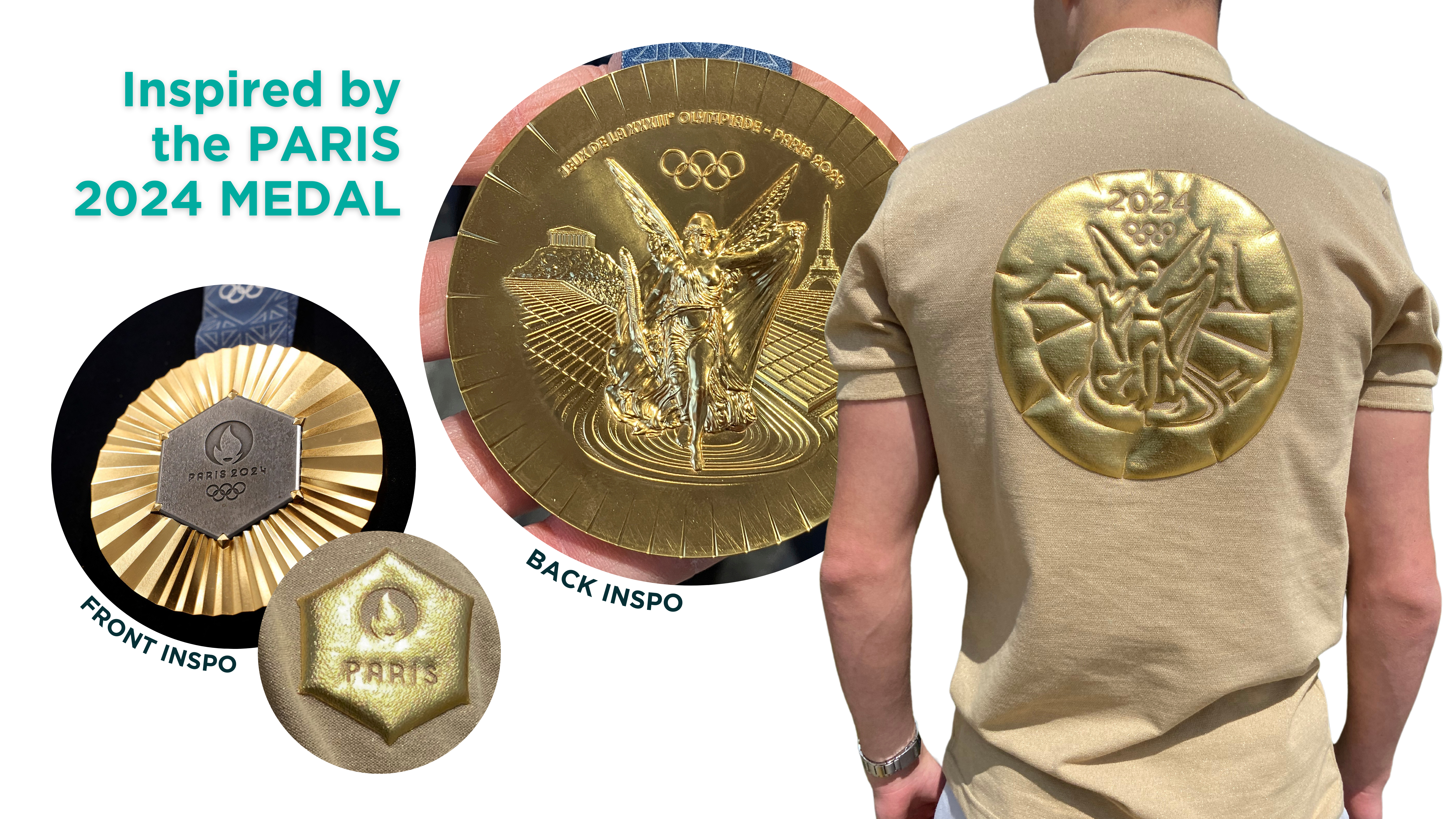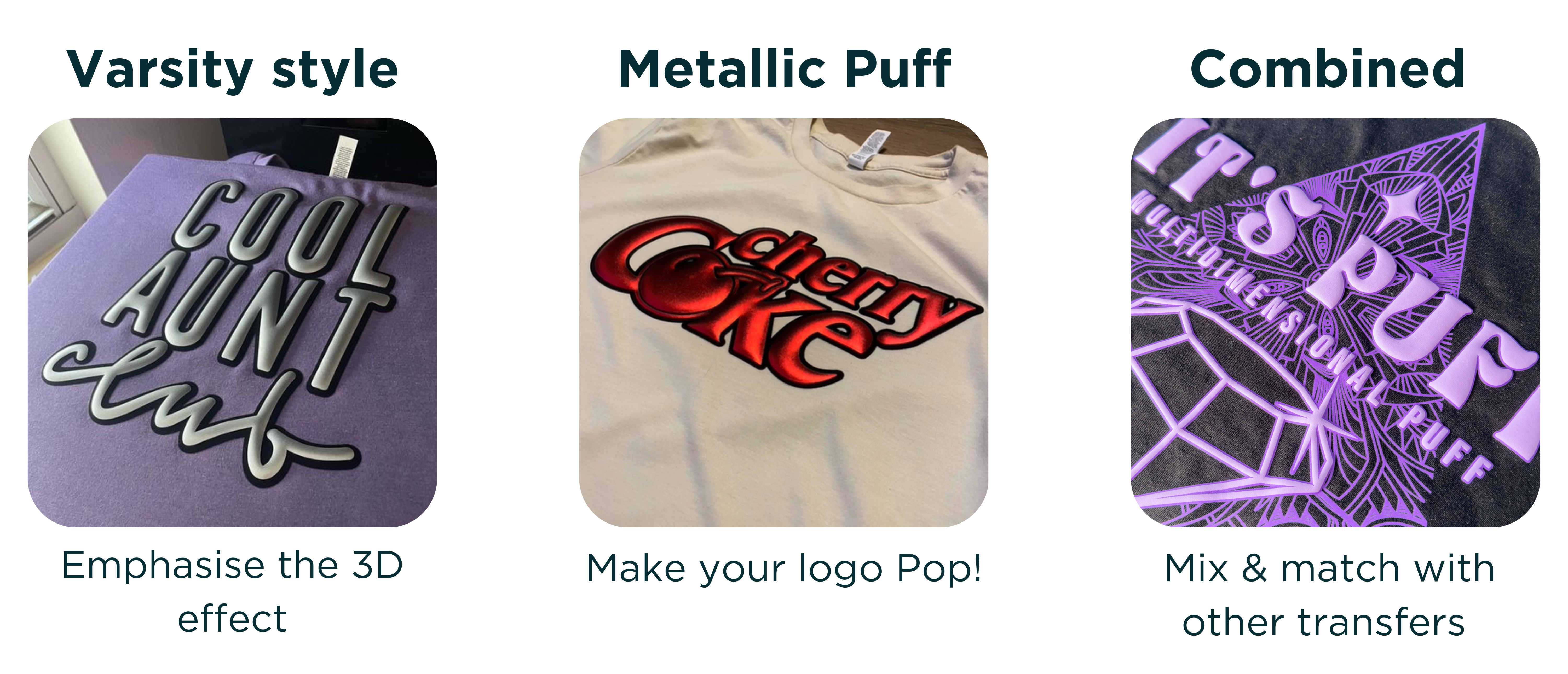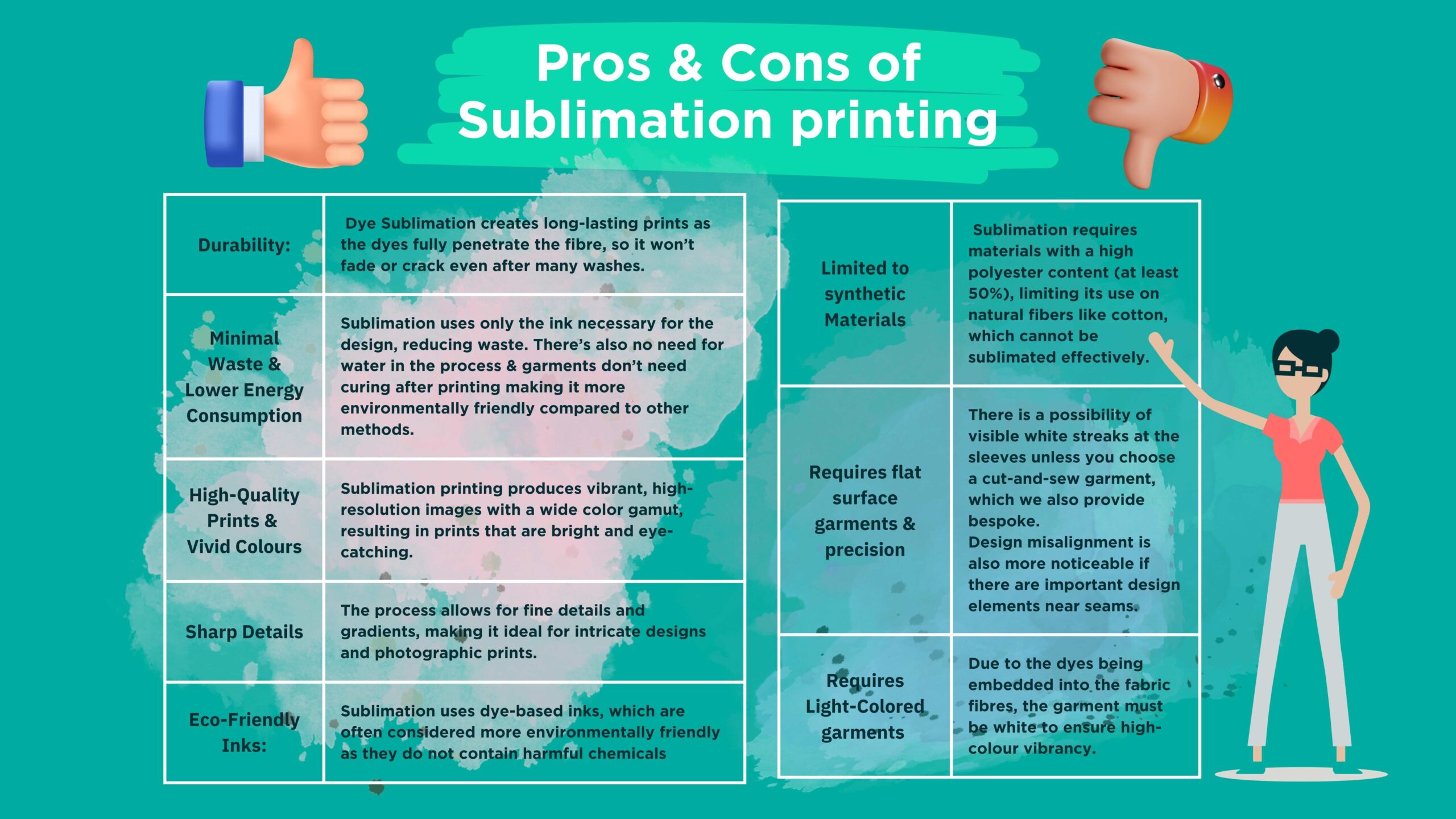Incorporating puff vinyl into your promo wear
Introducing a 3D Gold Medal Special Effect Polo in collaboration with B&C Collection. The Belgian-owned wholesaler have kindly provided us with their newest Polo style for the occasion. This unique statement piece is inspired by the PARIS 2024 medal that celebrates the essence of the games, with an eye-catching shine akin to the Olympic flame.
In this blog you’ll get a sneak peak of the concept behind this project and learn some tips about how to incorporate this 3D effect into your branding.

An Inside look at the 3D Olympic Medal:
This project was inspired by the new B&C MyPolo 180 in Meta Gold which is a high quality metallic stand-out piece with a classic, modern cut made of a fine yet weighty 180gsm pique fabric. We’ve quite literally never seen anything like it before! This unique polo drove our lovely artwork lead to recreate the Paris 2024 Olympic medal in celebration of the games this summer.
Once the design was set, the team sourced this gold metallic puff vinyl which is partly made from recycled polyurethane (PU). The design was then cut out and carefully weeded before getting heat pressed on the limited edition garments.
Puff screen-print vs Puff transfer – which one should I pick?
With the popularity of puff ink printing, you might be wondering how puff transfer differentiates. Let’s break it down;
- Puff transfers are ideal for smaller orders as they require fewer resources to set up, meaning they are a quicker and cheaper alternative to screen-printing.
- Whilst puff ink achieves a great result, it’s best to opt for transfer for high-shine and metallic finishes. Additionally, they won’t fade or crack over time.
- Well executed, puff transfers tend to be the more durable option, so long as proper care is taken when washing the garment.
What types of puff transfer are there?

Puff transfer is a versatile special effect, which is a great standalone for quick & easy branding whilst also combining well with other techniques. The technique creates high-impact designs, with a raised texture which adds depth to your graphics, making logos and messages more prominent and unforgettable.
A few things to consider before diving in:
- Puff vinyl can be applied to mixed fabric compositions, giving it wide range of application.
- The effect is ideal to decorate garments, bags, hats & accessories.
- Highly detailed designs should be considered when opting for puff transfer, as designs may require simplification for best results.
Curious to know how you can combine special effects for your design? Give us a call, our team will happily walk you through the process to find a solution for your specific requirements.
Article references:
Image 1: https://www.pinterest.co.uk/pin/1080230660608748774/ accessed 18.07.24
Image 2: https://www.613originals.com/products/puff-multidimensional accessed 18.07.24
Image 3: https://www.tiktok.com/@shellyward05/video/7389235820894489899 accessed 18.07.24
How to create an Edge-to-Edge Print with Sublimation
We hope you’re enjoying Pride month so far! To celebrate the occasion, we’re highlighting the benefits of dye sublimation through this joyfully vibrant design.
In this blog we’ll break down what is dye sublimation, how it works and what projects it’s best suited for. Let’s dive in!
What is dye sublimation & how does it work?
The concept of dye sublimation originated in 1950s when chemists discovered that certain dyes could sublimate and bind to synthetic fibres – through a mix of heat and pressure. By the 70s, this technique was introduced to the textile industry and has since grown more popular over the years.
Sublimation printing works by using heat and pressure from the press to transfer the dyes from a special printed paper straight onto the fabric. This chemical process causes the dyes to transition from solid to gas form without passing through a liquid phase, which then embed themselves into the garment material, binding to the synthetic fibres.
First, your design is printed onto a special transfer paper using sublimation inks. We use the SureColor F9400 printer which is especially made for this purpose. The printed paper is then placed onto the carefully pre-pressed fabric. This is done to prevent white streaks which are caused by fabric folds. A heat press applies high temperatures (usually around 400°F) and pressure, which causes the dye molecules to embed themselves directly onto the polyester fibers, creating a permanent, vibrant image that is resistant to fading and peeling.
What do I need to know to achieve best results?
- The technique requires upmost precision to limit creases as any folds will affect the print and be visible on the final product.
- Design requirements: The design printed must include a bleed to ensure full coverage.
- Dye sublimation is most suited to white garments with a high polyester content as the dyes merge with the synthetic fibres of the garment. Choosing to do this technique on a lightly coloured garment would result in a less vibrant colour pay-off, which could achieve a vintage look. However, it’s not possible to sublimate directly onto dark garments as the print won’t be visible.
- To enhance colour saturation & achieve a vibrant result, it’s best to print on fabrics with high polyester content as those fibers bond best with the dyes.
The Pros & Cons of dye sublimation for garment decoration:
The pros outweigh the cons when using dye sublimation to decorate garments. Compared to traditional screen-printing, this method requires fewer resources & consumes less energy to achieve one print, making it perfect for smaller batch orders & intricate designs. Another major perk to this method is its longevity – sublimated designs are more resistant to fading & wear, due to the dye integrating into the fabric fibres.
Additionally, sublimation is unique in its ability to produce full-coverage, edge-to-edge prints that encompass the entire garment, a feature that sets it apart from other printing techniques and which allows for more creative and impactful designs.

So, what type of project is dye sublimation best suited for?
Dye sublimation is ideal for flat surface garments such as sports jerseys, vests, towels, snoods and promotional T-shirts.
This Pride Design was printed onto the infamous Bella & Canvas Unisex EcoMax Tee which is 100% recycled, crafted from a blend of recycled Airlume cotton scraps and recycled PET bottles. This T-shirt is made using pre-dyed cotton, hence removing the need for water in the production process, conserving valuable resources. This is the perfect match in combination with the sublimation process, as it creates a final product which doesn’t involve water from start to finished product!
Is dye sublimation a sustainable decoration method? Well, that depends.
Due to requiring high polyester content, a garment decorated with sublimation printing has a longer lifespan than most. If you’re looking to decorate fewer items, this technique is ideal due to the lower energy consumption required to produce. It is not only cost effective but also generates high quality and durable prints. However, if you’re looking to decorate an organic garment made from 100% natural fibres, you may want to opt for screen-printing with water-based inks or Direct-To-Garment printing as these decoration methods are plastic-free and create a fully biodegradable product.
Whatever you decide – The team at Screenworks is here to support you from start to finish.
Happy printing and stay proud! 🌈
A RGB light interactive T-shirt design idea to elevate your merchandise!
At Screenworks, every month, we strive to push the boundaries of garment decoration by inspiring you with exciting new designs. This month, we wanted to change things up! – so we collaborated with UK artist Helenya Apostolou, to create an interactive T-shirt print, which moves under RGB lights!
Why an artist Collaboration?
Previously, our art and production team would brainstorm ideas by scouring the internet for design inspiration. Hours spent searching for copyright-free images often felt limiting and uninspiring – any creative team knows how challenging it can be to find the perfect image for a project.
That’s when the idea struck us: Why not collaborate with artists to create unique designs featuring special effects? This approach not only addresses copyright issues, but also provides a platform for lesser-known artists to share their work, bringing fresh perspectives to our industry! It’s a win-win really.
Additionally, we wanted to bring a stronger marketing focus to our product of the month – to give our clients insights into current trends and how they can leverage these to elevate their promotional merchandise. By inspiring creativity and out of the box thinking, we bring the soul in branded clothing.
So, what’s a RGB light reactive design, and how does it work?
This illusion was initially found in 1920’s by Russian set-designer Adrian V. Samoiloff, wanting to create smooth costume & scene transitions for theatre performances. Using red, green, and blue set lights, he used coloured props which combine the primary colours, with their opposite secondary colour, essentially cancelling each-other out to alter what we see – changing the scene or making it disappear entirely! This later inspired artists, such as Helenya to incorporate the same principles in their artwork. To understand this in depth, it’s important to grasp the basics of colour theory.
If you would like to learn more about the artist and her technique, visit her website at: https://helenyaapostolou.com/
Behind the scenes of this artist spotlight; Stage 1: The Idea – Contacting the Artist
Aiming to create an innovative special effect for music & festival merchandise, we researched relevant design trends and noticed psychedelic and pop-art influences are currently very popular in T-shirt designs. That’s when we discovered Helenya on TikTok, as she has sparked a lot of interest in the online art community with her RGB light-reactive art, making her the perfect fit for this project.
During our Teams call, Helenya shared that her TikTok account has grown rapidly over the past year. She also let us in on a little secret; she’s working on an exciting upcoming collaboration with a big-name brand, and we couldn’t be happier for her!
Stage 2: Design sampling & Colour Matching
To fit the theme, we proposed an illusion of a moving TV screen or a scene of dancing figures – which greatly inspired Helenya to create two original art pieces for us to test on both white and black T-shirts. We conducted paper prints to assess the effect under RGB strobe lights, ensuring the interactive element was visually striking – and then matched the inks to ensure a perfect result.
Stage 3: Screen printing the final design
Once set, we carried out a 7-layer screen-print, including a white base layer to make the colours pop, followed by the 6 following inks. The T-shirt featuring this is none other than the 100% recycled Bella+Canvas Eco-Max Tee, which is dyed without the use of water – quite impressive if you ask us.
Would you like to see this design in action?
Click here to view: (Flash warning) https://screenworks.co.uk/wp-content/uploads/2024/05/Helenya-Apostolou-Collab-Mobile-video-1.mp4
A few things to consider if you wish to ace this technique:
- The illusion effect comes mainly from the design itself, which must be composed of minimum 3 colours, including a transition colour where the designs overlap. To achieve that wow factor, accurate colour matching is required to ensure each shade reacts to the RGB lights.
- This design is best suited to dark or light garments but can work on any colour background depending upon the desired effect.
- As this technique lies in the design; multiple garment decoration options can be used in this instance, such as Transfer, Sublimation or Screen printing. Please contact our team if you’d like some guidance on which direction to go with.
Great, now how do I market this?
- RGB light reactive designs are perfect for music & night life merch… not to forget PRIDE events!
- Interactive products boost customer engagement by providing a more memorable & fun brand experience – they won’t forget it!
- Don’t limit this idea to one product: this interactive type of design is a great addition to hoodies, bucket hats, and products that will be hit by the light.
Would you like to collaborate with us?
Are you a supplier, client or artist interested in creating something new with us? If you’d like to feature in our next product of the month, or collaborate on marketing efforts please email us at [email protected]
Sources influencing this blog:
https://helenyaapostolou.com/blog/what-is-the-samoiloff-effect/
https://www.onstagelighting.co.uk/lighting-design/samoiloff-effect-colour/
Why Choose Screenworks for NFC Tags in Clothing?
At Screenworks, we understand the power of NFC technology in creating engaging and interactive brand experiences. Our NFC tags are specifically adapted for integration into clothing and garment decoration, offering a unique way to connect with your audience.
Key Features of Screenworks’ NFC Tags:
- Programmable Technology: Our NFC technology allows for seamless programming, enabling recipients to use their mobile phones to scan the embedded chip and retrieve data. Whether it’s a website URL or other forms of data, the possibilities are endless.
- Durable and Resilient: Designed to withstand the rigors of daily life, our NFC tags are tested to endure 100+ domestic wash cycles. With temperature resistance ranging from -20 degrees C to +70 degrees C, your clothing remains technologically advanced in various environments.
- Versatile Application: Screenworks offers diverse methods for applying NFC tags, including NFC transfers, NFC rubber badges, NFC woven badges, and NFC embroidered badges. Choose the method that suits your brand aesthetic and preference.
Elevate Your Brand with NFC-Enabled Clothing:
If you’re ready to embrace the future of fashion and enhance your brand’s connection with consumers, Screenworks has the perfect solution for you. Explore our short video demonstrating the seamless integration of NFC technology into clothing and discover the limitless possibilities it can offer to your brand.
How to Get Started:
Contact Screenworks today to explore the potential of NFC tags in clothing. Our dedicated team will work with you to tailor a solution that aligns with your brand’s vision and goals. Elevate your brand with Screenworks – where innovation meets fashion.
Elevate Your Merchandise with Sublimated Embroidery: The Iguana & Dragonfly Design
Discover the latest in garment decoration innovation with Screenworks. Each month, we push the boundaries of design, and this month, we’re showcasing the mesmerising combination of sublimated embroidery and applique techniques in our stunning iguana and dragonfly creation.
Here’s a look into how we’ve achieved this unique 3D effect:
Step 1: Conceptualisation & Design Digitisation
Our journey to creating this unique 3D effect begins with brainstorming sessions with our art & production teams.
Once the design is locked in, we swiftly digitise it for precision machine embroidery. This initial step lays the foundation, embroidering the white polyester thread base with its intricate details, setting the stage for the magic to unfold.
Step 2: Dragonfly applique embroidery
With the base ready, we move on to embroider the clear applique and dragonfly design onto the garment, ensuring every stitch is flawless. The use of clear applique brings depth and texture to the wings, elevating the design to appear almost lifelike.
Step 3: Full-colour image printing
In the meantime, we print the full-colour design on a specialist paper required for sublimation. The design always comes with a bleed outline to make sure it covers the embroidery completely.
Step 4: Sublimation printing
Now comes the moment of transformation. With the printed design cut to precision, we delicately transfer it onto the garment using a sublimation press. This innovative process bonds the ink to the polyester thread, seamlessly integrating the vibrant colours with the textured embroidery.
Step 5: Quality Assurance & Presentation
Before unveiling our creation to the world, we meticulously inspect every detail, ensuring perfection at every stitch. In just a few streamlined steps, we’ve transformed a photo into a truly unique 3D photorealistic print effect, which brings the design to life!
This design was created on a set-in sleeve, Build Your Own Brand: Unisex crew neck sweater which is 65% Cotton, 35% Polyester and is a firm favourite for its soft wearing comfort.
Some things to consider before diving in:
- Sublimated embroidery thrives on dark garments, as the artwork requires a bleed to fully integrate with the embroidered base.
- The technique requires 100% polyester thread to maximise the technique’s potential.
- It’s ideal for showcasing vibrant, detailed designs, making it perfect for photos and intricate patterns.
Ready to elevate your promotional merchandise? Here are some exciting usage ideas:
- Hats, bags, and synthetic fabric items are perfect canvases for this technique.
- Tap into seasonal trends with themed designs for Christmas or celebrate diversity with Pride-themed creations.
- Make a statement / stand out at special events, music festivals, and children’s wear with eye-catching, one-of-a-kind pieces.
Watch the process come to life in our video below!
If you’re still unsure how to incorporate this technique within your marketing, our team is available to help you through the process.
